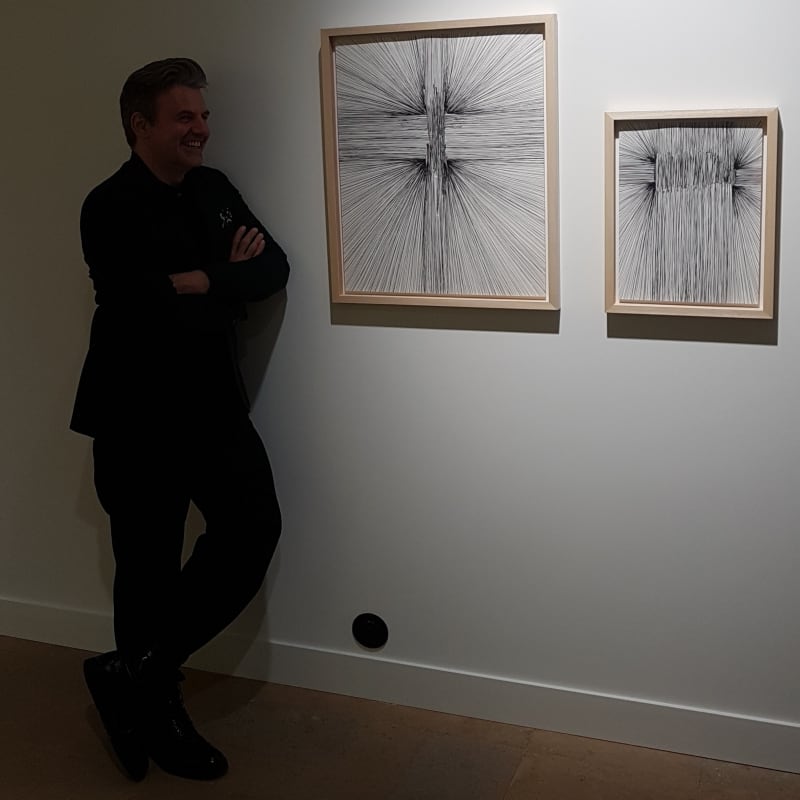Dessiner, c'est «se frayer un passage à travers un mur de fer invisible […] disait Van Gogh, entre ce que l'on sent et ce que l'on peut», un mur à «miner et traverser à la lime , lentement et avec patience »*.
2020, Lignes : dans cette série hypnotique de Jean-Michel Comte apparait cette érosion de la paroi du sentir, éruption ordonnée, subtile, raffinée presque, non moins puissante et offensive. L'Assaut. Sous le treillis, l'insulte, l'injure, l'invective. Émergence d'un cri, é-crit recouvert par ses mêmes lignes, de l'identité niée, du traumatisme enfoui, de l'humiliation expectorée.
En surface, un maillage, une toile de fines lamelles patiemment tissée, comme une peau striée-pansée qui recouvre et rappelle la tradition séculaire de la stéganographie: l'art du caché et l'invitation à le décrypter. Devant ces lignes, aucune dérobade: sur envoyé, sur sait la force du dessous. Elles sont les adjuvants du dit, renforçateurs du cri; glaives acérés de l'affront.
La brèche ouverte, on pouvait s'attendre à un déferlement, à un éboulis de mots, à la révélation du tabou. Mais la ligne en a décidé autrement. Dans sa série Ruminations , le trait se met à bouillonner, à emplir frénétiquement la surface, jusqu'à suspension du souffle. Le créateur reprend les rènes. Refaire surface au bout de la mine, performer, repousser les limites du possible, et du temps. La feuille se couvre et se découvre, révélant son potentiel vibratoire; la ligne frémit, imprimant le support de sa course. Chaque pièce répond à ses voisines en autant de vagues signifiantes. Condensés synergiques.
Côte à côte, toutes ces œuvres exhalent une immanente parenté. On voit surgir ce que les mots ne décrivent pas, la vie psychique dans son épaisseur et son impalpable turbulence.
L'œuvre de Jean-Michel Comte à la succulence de l'inclassable, bravant les étiquettes en référant leur ineptie. «Nul n'a jamais écrit ou peint […] que pour sortir […] de l'enfer» écrivait Antonin Artaud. Sans aucun doute, les dessins de Jean-Michel Comte puisent à l'encre de l'ombre donnant à voir l'art dans sa complexe nudité: langage autocréé, réalité recomposée, sauvagerie organisée.
* Lettre de Vincent Van Gogh à Theo Van Gogh, dimanche 22 octobre 1882
- Céline Muzelle, juin 2020
Historienne de l'art. Co-auteure du catalogue raisonné de l'oeuvre d'Aloïse Corbaz, elle concentre ses écrits et ses recherches sur l'Art Brut et singulier contemporains.
L'ASSAUT
“Drawing”, said van Gogh, “is working through an invisible iron wall that seems to stand between what one feels and what one can do. One must undermine the wall and grind through it slowly and patiently.”* 2020, Lignes: an erosion of the wall of feeling is apparent in this hypnotic series by Jean-Michel Comte, an orderly, subtle, almost refined eruption, yet no less powerful and offensive. The Assault. Beneath the canvas, insults, abuse, invective. The emergence of a howl, a written cry, covered by its own lines, one of denied identity, of buried trauma, of spat out humiliation. On the surface, a mesh, a web of narrow, patiently woven strips, as if covered by a striped, bandaged skin, recalling the age-old tradition of steganography: the art of the cryptic and the call to decipher it. There is no evading these lines: one feels, one knows, the strength of what lies beneath. They are additives to the word, they intensify the howl – whetted swords of affront. With the breach opened, we might have expected a torrent, a cascading scree of words, the exposure of a taboo. But the line decided otherwise, leaving the artist groping for words as diaphanous figures appeared. Silhouettes, isolated or in groups, whole or fragmentary, emerging like ghosts, and leaving the artist with no choice but to let them emerge. Flashes of being. Then the creator takes back the reins. He comes to, holding the pencil, working efficiently, pushing back the limits of the possible and of time. In his series Ruminations, the line effervesces, frenetically covering the surface, not even stopping to breathe. The sheet is covered and discovered, revealing its vibrant potential; the line of the pencil trembles, tracing the imprint of its course on the support. Each work reacts to those next to it in meaningful waves of condensed synergy. Side by side, the three series radiate an immanent kinship. What emerges cannot be described in words; it is psychic life in all its thickness and impalpable turbulence. Jean-Michel Comte’s work has the succulence of things that cannot be categorised. It defies labels by demonstrating their pointlessness. “No one has actually ever written, or painted, […] except to get out of hell.” wrote Antonin Artaud. It is beyond doubt that Jean-Michel Comte’s drawings are wrought from the ink of the shadows, revealing all the naked complexity of art. A self-created language, a reconstructed reality, organised savagery. *Vincent Van Gogh’s letter to Theo Van Gogh, Sunday October 22nd 1882 — Céline Muzelle, june 2020 / Translation, Jeremy Harrison
- Céline Muzelle, juin 2020
Art historian and co-author of the catalogue raisonné of Aloïse Corbaz’s work, Céline Muzelle researches and writes about contemporary Brut and Singular Art.
Traduction Jeremy Harrison


